Non-Destructive Testing of Installed Soil Nails
My three years of master research concerned the development of a Non-Destructive Test (NDT) procedure that can be used as an inspection tool during soil nail retaining wall construction and maintenance. This research was initiated to respond to the several occurrences of soil nail wall collapses in Texas. In fact, such infrastructure issues are not local to Texas. We are at the moment of real civil infrastructure peril, a crisis caused by the nations deteriorating civil infrastructure systems. Resources that are available for maintenance of such systems are often limited and misdirected, and actual inspection methods are limited to visual examinations. New techniques for inspection and evaluation of quality, safety, and serviceability of civil infrastructure must be developed and implemented. In this research, I investigated and field-tested a variety of NDT techniques, and a portable testing system was developed and finalized at the end this research. At its core, much of this research relies on vibration (induced by external impacts) detection and analysis through sensor devices coupled with advanced signal processing algorithms.
|
|
|
Soil Nail Defects (Half Fill)
|
|
|
Soil Nail Defects (No Grout)
|
|
|
|
Tradtional Quality Management (Inspector Onsite) |
Traditional Destructive Load Testing |
Specifically, this new NDT procedure will evaluate the integrity of the grout column surrounding the nail and measure the grouted length of the installed soil nails. The plan to accomplish this research involves a partnership between Texas Tech University (TTU) and Olson Engineering, Inc, a professional NDT consulting company. As the main researcher in the Texas Tech University research team, I have conducted a detailed evaluation of the existing NDT methodologies which show the greatest promise for this project. Based on my literature review and the suggestions from Olson Engineering, a set of NDT techniques was selected as the candidate methods as shown in Table 1.
Table 1 Summary of Selected Candidate NDT Methods
Problem need to be identified |
Selected Candidate NDT Methods |
Integrity of Grout |
Impact Echo, Sonic Echo/Impulse Response, Impedance Logging, Parallel Seismic |
Length of Nail |
Time Domain Reflectometry |
Surrounding Soil Properties |
Spectral Analysis of Surface Wave, Crosshole Seismic |
Stress wave Velocity in Grout |
Ultrasonic Pulse Velocity |
A test bed was constructed by Granite Construction company at the field site of TTU. 24 soil nails which represent the full range of conditions encountered in the field were installed at the TTU site. In this construction, I was responsible for preparing all the construction plans, installing all the artificial defects in the laboratory and onsite? monitoring the whole construction process.
|
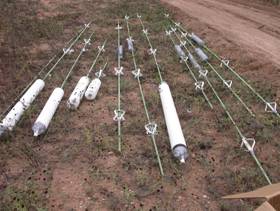 |
Soil Nail Drilling and Artificial Defect |
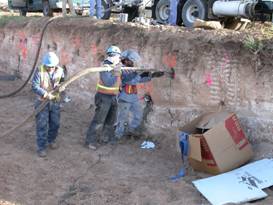 |
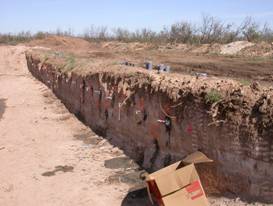 |
Grouting and Testbed After Construction |
After the construction of test bed, each selected NDT test method has been subjected to a more detailed evaluation through a series of field experiments. In this part, Olson Engineering was responsible for providing all the testing instruments and technical support by sending professional NDT engineer and training researchers at TTU. Through the first two rounds of testing, I have gained substantial first hand experiences on experiment setup, data interpretation of these selected NDT methods, especially by onsite cooperating with NDT professional engineer and attending the professional training.
|
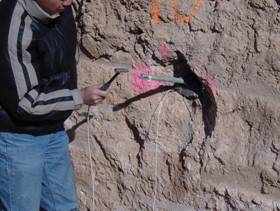 |
Ultrasonic Pulse Velocity
|
|
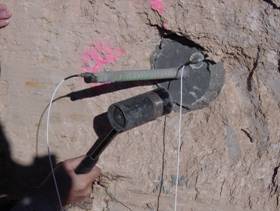 |
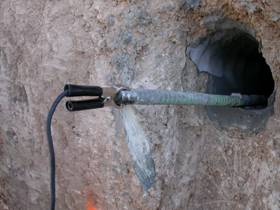 |
|
Time Domain Reflectometry
|
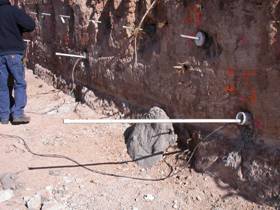 |
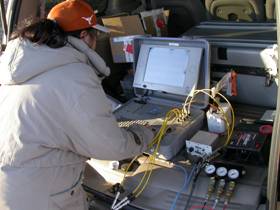 |
|
Cross-hole Seismic Data Collection
|
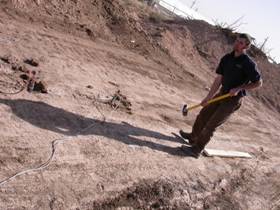 |
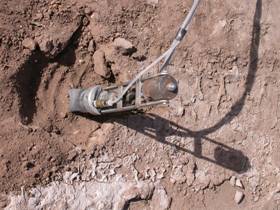 |
SASW (Spectral Analysis of Surface Wave)
|
|
Wave signal analysis is an important part of this research study. A large amount of testing data were gathered in three series of field tests that spans nearly two years. I analyzed most of these field testing data by using different signal processing algorithms to filter noise and to isolate interesting wave peak values. The data analysis results were compared with soil nails' as-built condition for verification. The soil nails' actual condition were identified through exhuming.
|
|
|
Exhuming and As-Built Condition Investigation |